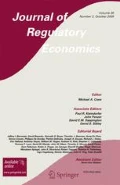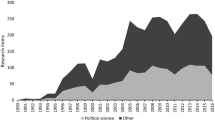Abstract
Populist clamor and recent Supreme Court decisions have renewed calls for increased regulation of corporate money in politics. Few empirical estimates exist, however, on the implications of existing rules on firms’ political spending. Exploiting within firm-cycle cross-candidate variation and across firm-cycle variation, we demonstrate that the regulation of PAC campaign contributions generates large spillovers into other corporate political expenditures such as lobbying. Using both high dimensional fixed effects and regression discontinuity designs, we demonstrate that firms constrained by campaign contribution limits spend between $549,000 and $1.6M more on lobbying per election cycle, an amount that is more than 100 times the campaign contribution limit. These results demonstrate that, similar to regulations in other domains of the economy, constraining specific corporate political activities often yields unintended effects.



Similar content being viewed by others
Notes
For instance, a 2015 New York Times/CBS News poll found that 85% of respondents believe that “fundamental” or “complete” changes are needed to the way political campaigns are financed (Confessore and Thee-Brenan 2015). A 2012 Reuters poll found that 75% of Americans of both political affiliations felt that there was too much money in politics while 76% thought that corporations should be required to disclose all political spending (Williams 2012; Yager 2012). Outside of the US, Australian Shareholders Association equated corporate campaign contributions to bribery and called for their cessation (Baker 2006).
Calls for greater disclosure are not limited to regulatory channels. Between 2007 and 2014, private investors have initiated over 350 stockholder proposals in an attempt to obtain improved disclosure of corporate political activities and formal statements of alignment between company values and political contributions (Goodridge and Jantz 2014; Northstar Asset Management 2012). These proxy battles have occurred at prominent firms such a Procter & Gamble, General Motors and 3M among many others.
A laundry list alternative corporate political activities could be provided—for example, firms may make in-kind contributions to campaigns, make philanthropic contributions to a politician’s preferred charity (see, for example, Bertrand et al. 2018), may threaten to contribute to opponents or may provide monetary contributions to political parties that act as pass-through entities.
Soft money contributions were direct transfers from firms’ corporate treasuries to political parties.
We completed supplementary analysis, relying exclusively on cross-sectional variation, that includes all 315 firms. The unreported results corroborate those reported in the paper.
One concern for identification is that the CEO may coincidently contribute to the same politicians as the PAC. There are persuasive reasons to believe that this is unlikely. First, Fremeth et al. (2013) demonstrate that, compared with other phases of their career, CEOs’ campaign contribution behavior changes dramatically once they ascend to the chief executives’ office. This suggests that CEO political contribution behavior is not driven by personal preferences and is responsive to their firms’ requirements.
F-tests reject the null hypothesis that the marginal CEO response to a PAC at the limit is equal to a non-limit contribution. Specifically, in Table 2 we test: \(H_0{:}\; \text {PAC contributed} = \text {PAC contributed at limit}\) and reject the null (\(p \,\,\mathrm{value}= 0.00\)). In Fig. 2 we test: \(H_0{:}\; \text {PAC gave between} \$4500{-}4999 = \text {PAC at limit}\) and similarly reject the null (\(p\,\,\text{ value }=0.00\)).
This underlying relationship also buttresses the view that campaign contributions are either an explicit or implicit “cost of access” to lawmakers (Kalla and Broockman 2015).
We elaborate on this in Online Appendix A.
We define industries according to the Fama-French 49 set of portfolios. Code available on the authors’ websites includes a concordance between four digit SIC codes from COMPUSTAT and the Fama-French portfolios.
As an additional test, we also run the main regression, but restrict the sample to only those firms that never made an at-limit PAC contribution. For this subsample, we, obviously, omit the PAC contributed at limit variable, only retaining the PAC contributed indicator. The results from this regression show a small point estimate with a wide standard errors, supporting the conclusion that regulations are driving behavior.
We also ran regressions that include firm-specific time trends. The results are nearly identical to those presented in Table 6.
A recent paper by Bertrand et al. (2018) considers this possibility by demonstrating how charities benefit from greater corporate philanthropy when they are connected to local congressmen that are of particular relevance to Fortune 500 and S&P 500 firms.
References
Altonji, J. G., Elder, T. E., & Taber, C. R. (2005). Selection on observed and unobserved variables: Assessing the effectiveness of catholic schools. Journal of Political Economy, 113(1), 151.
Baker, R. (2006). Are our politicians for sale?; Focus—Political donations. The Age (Melbourne, Australia) (2006/05/24).
Bebchuk, L. A., & Jackson, R. J, Jr. (2012). Shining light on corporate political spending. Geo. LJ, 101, 923.
Bertrand, M., Bombardini, M., Fisman, R., & Trebbi, F. (2018). Tax-exempt lobbying: Corporate philanthropy as a tool for political influence. Technical report, National Bureau of Economic Research.
Bertrand, M., Bombardini, M., & Trebbi, F. (2014). Is it whom you know or what you know? An empirical assessment of the lobbying process. American Economic Review, 104(12), 3885–3920.
Blanes i Vidal, J., Draca, M., & Fons-Rosen, C. (2012). Revolving door lobbyists. American Economic Review, 102(7), 3731–3748.
Bombardini, M., & Trebbi, F. (2011). Votes or money? Theory and evidence from the US congress. Journal of Public Economics, 95(7), 587–611.
Chamon, M., & Kaplan, E. (2013). The iceberg theory of campaign contributions: Political threats and interest group behavior. American Economic Journal: Economic Policy, 5(1), 1–31.
Cohen, L., & Malloy, C. J. (2014). Friends in high places. American Economic Journal: Economic Policy, 6(3), 63–91.
Confessore, N., & Thee-Brenan, M. (2015). Poll shows Americans favor overhaul of campaign finance. New York Times (New York, USA) (2015/06/02).
de Figueiredo, J. M., & Cameron, C. M. (2009). Endogenous cost lobbying: Theory and evidence. In CELS 2009 4th Annual Conference on Empirical Legal Studies Paper.
de Figueiredo, J. M., & Richter, B. K. (2014). Advancing the empirical research on lobbying. Annual Review of Political Science, 17, 163–185.
Deryugina, T., & Hsiang, S. M. (2014). Does the environment still matter? Daily temperature and income in the united states. Technical report, National Bureau of Economic Research.
Ellis, C. J., & Groll, T. (2014). Lobbying as costly persuasion with legislative subsidies. Available at SSRN 2546550.
Fremeth, A., Richter, B. K., & Schaufele, B. (2013). Campaign contributions over CEOs’ careers. American Economic Journal: Applied Economics, 5(3), 170–188.
Gelman, A., & Imbens, G. (2017). Why high-order polynomials should not be used in regression discontinuity designs. Journal of Business & Economic Statistics (just-accepted).
Goodridge, J., & Jantz, C. (2014). Fiduciary responsibility in corporate political spending: Governance, transparency and accountability. Available at https://northstarasset.com/wp-content/uploads/2014/03. Accessed April 18, 2015.
Hahn, J., Todd, P., & Van der Klaauw, W. (2001). Identification and estimation of treatment effects with a regression-discontinuity design. Econometrica, 69(1), 201–209.
Hall, R. L., & Deardorff, A. V. (2006). Lobbying as legislative subsidy. American Political Science Review, 100(01), 69–84.
Kalla, J. L., & Broockman, D. E. (2015). Campaign contributions facilitate access to congressional officials: A randomized field experiment. American Journal of Political Science, 60(3), 545–558.
Kang, M. S., & Shepherd, J. M. (2011). The partisan price of justice: An empirical analysis of campaign contributions and judicial decisions. New York University Law Review, 86, 69.
Lake, J. (2015). Revisiting the link between PAC contributions and lobbying expenditures. European Journal of Political Economy, 37, 86–101.
Lee, D. S., & Lemieux, T. (2010). Regression discontinuity designs in economics. Journal of Economic Literature, 48(2), 281–355.
Milyo, J., Primo, D., & Groseclose, T. (2000). Corporate PAC campaign contributions in perspective. Business and Politics, 2(1), 75–88.
Myers, B. W. (2005). Corporate political activity and asset pricing. Available at SSRN 950104.
Northstar Asset Management, A. (2012). Shareholder rebuttal to the procter & gamble company (p&g) opposition statement regarding say on political contributions proposal. Available at www.pginvestor.com/Cache/16776020.pdfIID=4004124&FID=16776020&O=3&OSID=9 and via EDGAR. Accessed April 18, 2015.
Ovtchinnikov, A. V., & Pantaleoni, E. (2012). Individual political contributions and firm performance. Journal of Financial Economics, 105(2), 367–392.
Sabato, L. (1985). PAC power: Inside the world of political action committees. New York: WW Norton & Company Incorporated.
Stratmann, T. (1992). Are contributors rational? Untangling strategies of political action committees. Journal of Political Economy, 647–664.
Tripathi, M., Ansolabehere, S., & Snyder, J. M. (2002). Are PAC contributions and lobbying linked? New evidence from the 1995 lobby disclosure act. Business and Politics, 4(2), 131–155.
Williams, W. (2012). Favors and loot for sale: How fund-raising buys political influence. The Augusta Chronicle (Georgia, USA) (2014/09/11).
Yager, J. (2012). Poll: Majority wants corporate money out of politics. Available at https://thehill.com/blogs/ballot-box/campaign-ads/264087-poll-majority-want-corporate-money-out-of-politics. Accessed Mar 27, 2015.
Author information
Authors and Affiliations
Corresponding author
Additional information
This paper has benefited from comments and suggestions from John de Figueredo, Kishore Gawande, Steve Haber, Guy Holburn, Isaac Holloway, Chad Kendall, Margaret Loudermilk, Romel Mostafa, Davin Raiha and Rob van Houwleing. Earlier versions of this paper have been presented at the Canadian Economic Association Annual Meetings 2015, the 2015 University of Michigan Conference on Special Interests in US Politics, the Canadian Law and Economics Meetings 2015, the Southern Political Science Association Meetings 2016, the University of Toronto, Brock University and the the University of Chicago’s How Incomplete is the Theory of the Firm 2017.
Electronic supplementary material
Below is the link to the electronic supplementary material.
Rights and permissions
About this article
Cite this article
Fremeth, A., Richter, B.K. & Schaufele, B. Spillovers from regulating corporate campaign contributions. J Regul Econ 54, 244–265 (2018). https://doi.org/10.1007/s11149-018-9369-7
Published:
Issue Date:
DOI: https://doi.org/10.1007/s11149-018-9369-7




